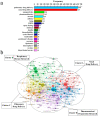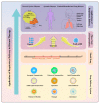A Review of Non-Invasive Drug Delivery through Respiratory Routes
- PMID: 36145722
- PMCID: PMC9506287
- DOI: 10.3390/pharmaceutics14091974
A Review of Non-Invasive Drug Delivery through Respiratory Routes
Abstract
With rapid and non-invasive characteristics, the respiratory route of administration has drawn significant attention compared with the limitations of conventional routes. Respiratory delivery can bypass the physiological barrier to achieve local and systemic disease treatment. A scientometric analysis and review were used to analyze how respiratory delivery can contribute to local and systemic therapy. The literature data obtained from the Web of Science Core Collection database showed an increasing worldwide tendency toward respiratory delivery from 1998 to 2020. Keywords analysis suggested that nasal and pulmonary drug delivery are the leading research topics in respiratory delivery. Based on the results of scientometric analysis, the research hotspots mainly included therapy for central nervous systems (CNS) disorders (Parkinson's disease, Alzheimer's disease, depression, glioblastoma, and epilepsy), tracheal and bronchial or lung diseases (chronic obstructive pulmonary disease, asthma, acute lung injury or respiratory distress syndrome, lung cancer, and idiopathic pulmonary fibrosis), and systemic diseases (diabetes and COVID-19). The study of advanced preparations contained nano drug delivery systems of the respiratory route, drug delivery barriers investigation (blood-brain barrier, BBB), and chitosan-based biomaterials for respiratory delivery. These results provided researchers with future research directions related to respiratory delivery.
Keywords: COVID-19; nanoparticles; nasal drug delivery; pulmonary drug delivery; scientometric analysis.
Conflict of interest statement
The authors declare no conflict of interest.
Figures






Similar articles
-
Current State and Future Directions of Intranasal Delivery Route for Central Nervous System Disorders: A Scientometric and Visualization Analysis.Front Pharmacol. 2021 Jul 12;12:717192. doi: 10.3389/fphar.2021.717192. eCollection 2021. Front Pharmacol. 2021. PMID: 34322030 Free PMC article.
-
Application of Chitosan and its Derivatives in Nanocarrier Based Pulmonary Drug Delivery Systems.Pharm Nanotechnol. 2017;5(4):243-249. doi: 10.2174/2211738505666170808095258. Pharm Nanotechnol. 2017. PMID: 28786352 Review.
-
Mapping Knowledge Structure and Research Frontiers of Ultrasound-Induced Blood-Brain Barrier Opening: A Scientometric Study.Front Neurosci. 2021 Jul 14;15:706105. doi: 10.3389/fnins.2021.706105. eCollection 2021. Front Neurosci. 2021. PMID: 34335175 Free PMC article.
-
Intranasal Delivery of Nanoformulations: A Potential Way of Treatment for Neurological Disorders.Molecules. 2020 Apr 21;25(8):1929. doi: 10.3390/molecules25081929. Molecules. 2020. PMID: 32326318 Free PMC article. Review.
-
A Review on Chitosan in Drug Delivery for Treatment of Neurological and Psychiatric Disorders.Curr Pharm Biotechnol. 2022;23(4):538-551. doi: 10.2174/1389201022666210622111028. Curr Pharm Biotechnol. 2022. PMID: 34161209 Review.
Cited by
-
Inhalable Nano Formulation of Cabazitaxel: A Comparative Study with Intravenous Route.Macromol Biosci. 2025 May;25(5):e2400567. doi: 10.1002/mabi.202400567. Epub 2025 Jan 30. Macromol Biosci. 2025. PMID: 39888152 Free PMC article.
-
Ingestion of Fluids of the Ocular Surface Containing Eye Drops of Imidazole Derivatives-Alpha Adrenergic Receptor Agonists as Paragons.Pharmaceuticals (Basel). 2024 Jun 9;17(6):758. doi: 10.3390/ph17060758. Pharmaceuticals (Basel). 2024. PMID: 38931425 Free PMC article. Review.
-
Recent Advances in the Polish Research on Polysaccharide-Based Nanoparticles in the Context of Various Administration Routes.Biomedicines. 2023 Apr 28;11(5):1307. doi: 10.3390/biomedicines11051307. Biomedicines. 2023. PMID: 37238978 Free PMC article. Review.
-
Quantitative Analysis of Salmon Calcitonin Hydroxyapatite Nanoparticle Permeation to substantiate Non-Invasive Bone Targeting via Sublingual Delivery.AAPS PharmSciTech. 2025 Mar 18;26(4):88. doi: 10.1208/s12249-025-03068-w. AAPS PharmSciTech. 2025. PMID: 40102334
-
Optimized inhaled LNP formulation for enhanced treatment of idiopathic pulmonary fibrosis via mRNA-mediated antibody therapy.Nat Commun. 2024 Aug 10;15(1):6844. doi: 10.1038/s41467-024-51056-8. Nat Commun. 2024. PMID: 39122711 Free PMC article.
References
-
- Pham D.T., Chokamonsirikun A., Phattaravorakarn V., Tiyaboonchai W. Polymeric micelles for pulmonary drug delivery: A comprehensive review. J. Mater. Sci. 2021;56:2016–2036. doi: 10.1007/s10853-020-05361-4. - DOI
Publication types
Grants and funding
LinkOut - more resources
Full Text Sources

